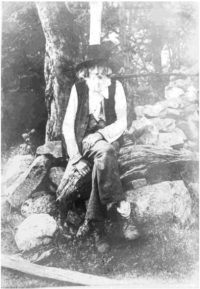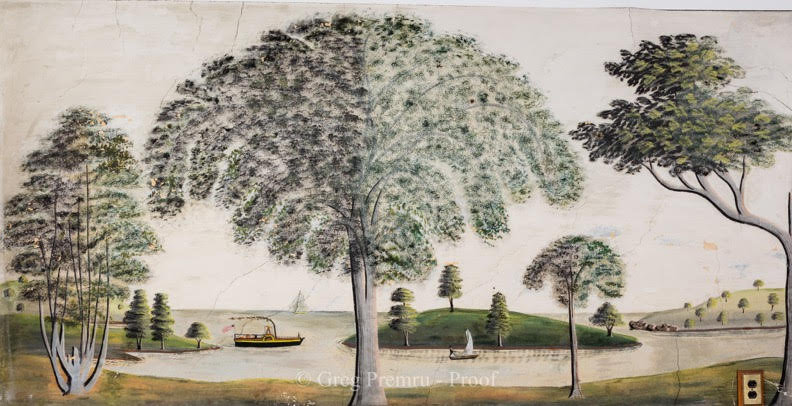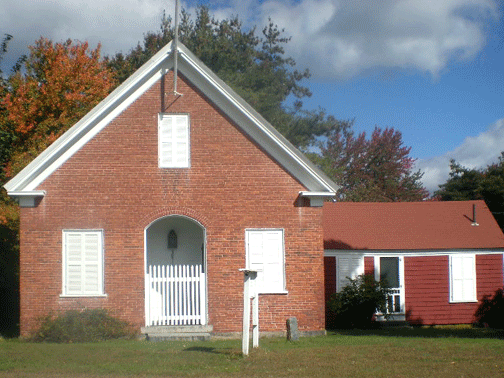Author Archives: KGeo
Murder at the Sawmill: the Story of Nate Nutting Retold
Written by Judy Adams, 2009
Nate Nutting lived in Groton during the late 19th century. His home was on a “highway” laid out in 1672 from the Boston Road to the present Old Ayer Road. It was called Hill Side Road in the 1875 Atlas of Middlesex Co., Mass., which shows the site of his house and sawmill. By Nate Nutting’s time, this road had been abandoned due to later road developments and the site was little more than a track through the woods. Today the western end is Indian Hill Road, the eastern end is named for Nate Nutting and the section between is a trail through conservation land.
If you go there today, you will wonder how there was ever enough water to turn a water wheel. Whoever built the sawmill could see that if he dammed up the small stream flowing under the road and over the embankment, he could hold back enough water to turn a mill wheel when he opened the sluiceway, in the Spring at least! Historians tell us that the water table was higher then, so looking back we should imagine more water flowing through the site in those days.
The remains of the earthen dam can still be seen. The stone lined sluiceway still channels the stream from the dam, under the road, and toward the embankment where the wheel once stood. The mill foundation is still there, built of huge stone blocks. And you can see the foundation of the house, between the mill and the road, made of fieldstone with trees and brush now growing in it. On one side of the foundation you can find bricks under the leaf cover, the remains of Nate’s fallen chimney. In the overgrown area below the mill there are remains of some of the mechanisms of the mill operation.
In her book, “Groton Plantation,” Virginia May tells us the story of Nate Nutting. He and his wife were poor simple folk who probably kept pretty much to themselves. When they had to go to the village, they hitched their old milk cow to a wagon. Plodding along, dressed in their shabby country clothes, it’s not hard to image that some thoughtless people laughed and joked about them. A group of boys and young men, who wandered around town, had often harassed Nate and his wife at their isolated home, drinking up their cider and making a nuisance of themselves. Nate had reported this to the local constable but what could be done when they lived so far from town and there was no way to call for help when they needed it. Nate finally decided not to put up with it any longer, to be ready to defend himself and his property with his gun.
On the evening of May 16, 1887, a man made his way through the woods to see Nate Nutting about something. Mrs. May suggests in her book that he had had too much to drink. This seems likely, because an argument started, and the man began to threaten Nate, chasing him up the stairs. Nate was not to be treated badly again; he grabbed his rifle and shot the man. On the stairwell he couldn’t miss; the man was killed and Nate went to jail. But folks sympathized with Nate and his wife. They knew about the young ruffians who terrorized some of the more vulnerable citizens. These folks bailed Nate Nutting out of jail and convinced the Grand Jury that the killing was justifiable homicide. So Nate was let out and went back home to his wife on the Hill Side Road. It’s unlikely anyone came around to bother him again.

Video: 1976 Bicentennial Parade, Groton
Jonathan D. Poor Mural Preservation Project
The Oliver Prescott House on Old Ayer Road was recently purchased by Indian Hill Music. Several walls in the house are decorated with colorful landscape murals signed by J. D. Poor that were painted circa 1835. Jonathan D. Poor was the nephew of well-known itinerant painter Rufus Porter, whose murals decorate the walls of many old buildings in New England. Recently it has been suggested that Poor was actually more prolific than his better-known uncle and mentor.
Indian Hill Music recognized that these murals would likely be lost as the fate of the building remains unknown. The organization decided, then, to donate two of the painted walls to the Groton History Center to ensure that this element of local folk art would remain in town.
The Groton Inn, which will soon again be a focal point in the center of town, has graciously offered to display the murals in their lobby space where they will be more easily viewable and accessible to town residents and visitors. As owners of the murals, the Groton History Center will remain stewards of these important works of art and will loan them to the Inn on a long-term basis.
We are requesting funding from the Groton CPC, Bruce J. Anderson Foundation, and private donors, to hire experienced professionals for stabilization of the walls, removal of the murals, transportation of the murals, conservation and restoration work needed on the murals, and installation and display of the murals in the Groton Inn.
There is a sense of urgency with this project that necessitates its completion as soon as possible. With the Oliver Prescott House unoccupied, the murals are completely vulnerable to many potential threats of damage and destruction such as temperature fluctuation, water, and fire. These murals are unique to Groton and they are a New England treasure that we must look at as irreplaceable.

Photograph by Greg Premru
Video: An Evening with Steve Kornacki
On January 25 at Lawrence Academy Steve Kornacki presented a talk about how the role of media has changed over time with the new styles of communication embraced by today’s politicians. What are its effects and how will it impact the way campaigns are run? How has it changed our view of politics
Steve Kornacki regularly fills in for Chris Matthews. He has consistently appeared in prime time on election nights providing real-time analysis of voting patterns, exit polls, and electoral data.
His work has also appeared in the Wall Street Journal, New York Times, New York Daily News, New York Post, Boston Globe, Daily Beast and at Capital New York, where he’s written a series of deeply-researched profiles of prominent New York political figures. Steve is a native of Groton, graduated from Groton-Dunstable High School and Boston University.
Groton During WWI
War Effort at Home in Groton
Somewhere in France April 14 [1918]
Dear Friend—Will write you a few lines before going to mess. I got your box Friday and believe me was some pleased with it. Ralph Lawrence says he is going to write you soon. We both thank you and all the Willing Workers for the good things in it. There is not much I can write, but we are having plenty of excitement now. The papers probably tell you more than we know of what is going on. Let’s hope this is the beginning of the end and everything will soon be righted . . .
Yours sincerely,
Private Leroy Johnson
Co. B. 101st U.S.A.A.E.F.
[Part of letter written from Private Leroy Johnson to Miss Josie Gainey, President of the Willing Workers. Published in Turners Public Spirit, May 18, 1918.]
During World War I, while soldiers trained on American soil and went on to battle in Europe, the citizens left at home worked on their own war effort. The Groton Town Diaries reveal various organizations in town doing their part to support the United States in the war. A War Savings Stamp Committee urged people of Groton to purchase savings stamps, and Liberty Loan rallies were held at the Town Hall to motivate people to invest in government bonds. The Groton branch of the Red Cross sent socks, sweaters, and gauze strips by the thousands to France each month. The Groton Fuel Committee managed the rationing of coal in town. The Willing Workers, a club organized in October 1917, sent supplies to American soldiers as well as boxes containing tobacco, cigarettes, candy and other comforts.
This massive town-wide support even included school students in town. In the 1918 Groton Town Report, the School Superintendent, Edward P. Fitts, notes:
“One not in close touch with the schools can hardly realize what a number of calls are made upon the time and strength of the teachers and pupils for work outside of their regular school duties. They are asked to sell War Savings Stamps and keep record of the number who buy and the amount in dollars, to sell Liberty Bonds, to do Red Cross work, to make card catalogues of enlisted men and going to Ayer on Saturdays to do this service, to have Humane Day exercises, Bird and Arbor Day exercises, to canvass farmers for amount of food production, to enroll boys for farm labor during the summer, to encourage home gardens, to form pig clubs, to manufacture tables and chairs for camp use, to urge and encourage military drill, to carry out a Thanksgiving Peace program, to give and urge others to give for the United War Work campaign.
“In all these and other ways we have gladly responded so far as we have been able and so have helped on the cause dear to our hearts.” ■
Video: Groton Junction & The Railroad
On Sunday September 17th, Carl Byron from the Boston & Maine Railroad
Historical Society spoke about Groton Junction, a hub of activity in the 19th century. South Groton or Groton Junction (now Ayer) became a center for both railroad freight and passengers.
Holiday Open House
The Groton History Center invites all our neighbors, friends and first time visitors to the Holiday Open House at the Governor George Boutwell House on Sunday, December 11th, from 2-4 pm. We are so excited by the wonderful changes to this historic 1851 home. Rooms are painted in striking colors, new wallpaper has been hung, and period lighting and carpeting installed. The furniture has been restored and polished and along with our paintings, rearranged to make the house a new experience
This event will be our traditional Holiday Open House with homemade cookies and hot spiced cider. The Groton Garden Club will provide arrangements to enhance the beauty of the season. Music by Indian Hill students will be played as you stroll the rooms. See our antique sampler collection. Visit the President Ulysses S. Grant bedroom and Governor Boutwell’s office on the second floor, which has not been on view for several years.
The Groton History Center is so grateful to the volunteers, members and generous benefactors, who have made this renovation possible. Please stop by and see a part of Groton’s history in living color.
Video: A Walking Tour of Historic Groton Homes
On Sunday, September 18th, 2016, Nicolas Langhart took us on a walking tour to examine the variety of architectural styles of Groton’s historic homes located in the town’s center. Mr. Langhart is the director of the Forbush Memorial Library in Westminster, holds an MA in historic preservation from Cornell University and has served as property manager at Historic New England, Boston. He has taught courses on the history of architecture on Long Island, NY and at Clark University, Worcester State and WPI. He instructs docents at Preservation Worcester and is currently teaching courses on New England architecture in the ALFA program at Fitchburg State University.
Video provided by John Ellenberger.
Get Schooled at the 2016 GHC Summer Ramble
The Groton History Center invites you and your children to our much anticipated Annual Summer Ramble. This year we invite you to walk through Groton’s historic one-room schoolhouses on July 17, 2016, from 2 pm to 5 pm. We have two such Groton schoolhouses preserved today, one located on Sandy Pond Road in Ayer (formerly Groton) and one on Chicopee Row in Groton.
 Guided tours of the Sandy Pond Schoolhouse will be 2 – 4 pm with schoolyard games for children behind the building. This schoolhouse, now in Ayer, is located at the junction of Sandy Pond Road, Willow Road and Westford Road. Parking will be available along Westford Road.
Guided tours of the Sandy Pond Schoolhouse will be 2 – 4 pm with schoolyard games for children behind the building. This schoolhouse, now in Ayer, is located at the junction of Sandy Pond Road, Willow Road and Westford Road. Parking will be available along Westford Road.
The Chicopee Row Schoolhouse and its outhouse will be open from 3 -5 pm. Members of the Sawtell (Chicopee Row) Schoolhouse will be there to greet and inform visitors about the schoolhouse experience. The school is found on the corner of Chicopee Road and Sawtell Dr. Parking will be available along the sidewalk side of Sawtell Dr.
Please join us for this exciting and informative Ramble. Refreshments will be served. This program is possible thanks to the Sandy Pond Schoolhouse Association, the Chicopee Row Schoolhouse Association and a generous grant from the Groton Commissioners of Trust Funds. Donations to support the work of the Groton Historical Society at The Groton History Center will be gratefully accepted. Please note there are no bathrooms at these venues.